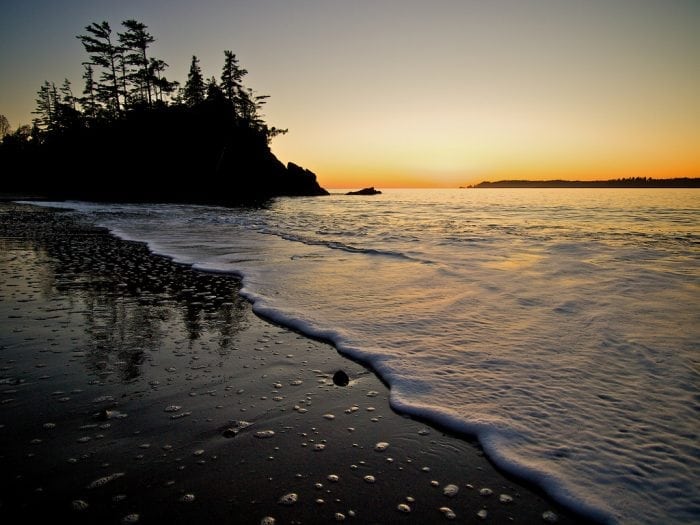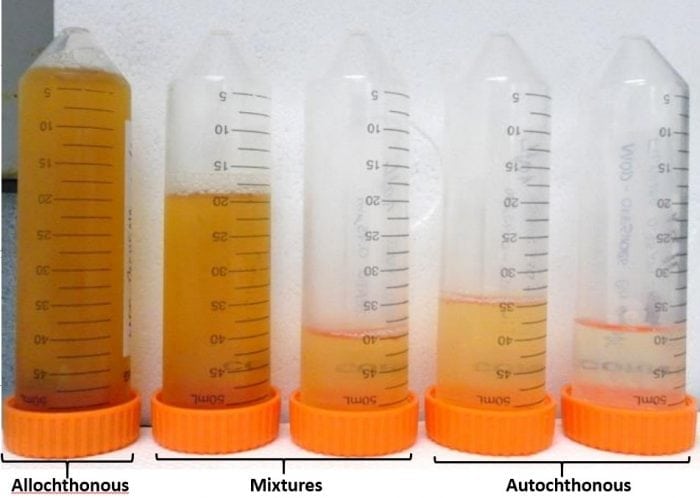
Contamination of the aquatic environment has been a growing problem mainly due to population and industrial increase. Often, toxic substances (known or not!) are released indiscriminately, and among them are metals. Once present in the aquatic environment, metals may cause toxic effects, especially in the early life stage of aquatic organisms. Of all marine organisms, mussel larvae are known to be the most sensitive to most metals and are often used in setting marine water quality guidelines.
At least in freshwater environments, one of the most important physicochemical parameters related to the reduction of the toxicity of metals to aquatic animals is natural organic matter (NOM) dissolved in the water. Aquatic organic matter may originate from the decomposition of lignin-rich plant material and from dead organic biomass, called allochthonous NOM. Alternatively, it can be synthesized by aquatic microorganisms (bacteria, algae etc), called autochthonous NOM.
The protective effect of organic matter against metal toxicity in aquatic organisms is related to its ability to complex metals, thereby decreasing their bioavailability. In freshwater environments, it is known that NOMs of allochthonous origin from rivers and lakes often have excellent protective properties due to their high concentration of components, which avidly bind metals. However, when it comes to saltwater environments where NOM is mainly of autochthonous origin or mixed origin, little is known about the possible protective abilities of these substances.
For the first time in literature, NOMs extracted from four different sites in Canada close to Bamfield, BC, on the Pacific coast, and one site in Brazil close to the Rio Grande, RS, on the Atlantic coast, were evaluated for their abilities to protect the early life stages of mussels from three different metals: copper, zinc, and lead. After chemical characterization, it was possible to confirm that two NOMs had autochthonous origin, one had allochthonous origin and last two were classified as a mixture between allochthonous and autochthonous. In order to evaluate the possible protective capacities of these different organic matters, ionoregulatory parameters (the activity of carbonic anhydrase and Mg-Ca-ATPase enzymes) and redox status (lipid peroxidation) were measured in the mussel larvae, since metals have the ability to alter these physiological parameters.
It is important to emphasize that the mussel larvae used in this study came from different geographic regions. While the Mytilus trossulus species originated from the North Pacific, the second species Mytilus galloprovincialis originated from the Mediterranean and is an invasive species in the North Pacific. In the literature, it is known that these congeners differ in their sensitivities to temperature and salinity. In general, invasive species have their physiology more adaptable to new environments, thus being more tolerant of environmental stressors when compared to native species.

Credit: Lygia S. Nogueira
After spawning and egg fertilization, the larvae obtained were exposed to metals by themselves, NOMs from the different sources by themselves and finally to combinations of individual metals with the different NOMs. All the exposures were at environmentally-relevant concentrations. In total, 72 treatments divided into three physiological parameters were analyzed for each species.
Based on the physiological responses, the two congeners differed in their sensitivities to the metals, both in isolated exposures and in combinations with organic matters. As expected, there was a greater sensitivity of the native species (M. trossulus) to environmental stressors (in this case metals and the combination of metals with organic matters) when compared to the invasive species (M. galloprovincialis).
However, it was also demonstrated the same pattern of physiological alterations occurred in two different species of aquatic animals after exposure to organic matters from different sources (allochthonous and autochthonous). In this case, a change in redox status was observed through the higher incidence of lipid peroxidation in early life stages of both M. trossulus and M. galloprovincialis. Thus, marine NOMS may have some negative effects.
However, physiological effects considered positive were also observed in the mussel larvae when exposed to the marine organic matter from different sources as well as metals by themselves and combination of metals-organic matter. These positive effects refer to the increased activity of the ionoregulation-related enzymes, carbonic anhydrase and Mg-Ca-ATPase.
Another important finding of this work was the influence of the origin of organic matter on the nature of the responses. Surprisingly, the NOMs of mixed autochthonous and allochthonous origin appeared to offer the least protection, suggesting a canceling out of effects. Although some recent studies with copper have concluded that there is no need for the chemical composition of marine organic matter to be taken into account in ecotoxicological studies, this investigation has shown the opposite. Indeed, simulations carried out by grouping the treatments of the different NOMs into one source showed that many physiological changes observed before were lost after the grouping of the treatments.
Thus, the results demonstrate the importance of taking into account the quality of marine organic matter in ecotoxicological trials. In addition, the study reinforces the importance of distinguishing between native and invasive species in the evaluation of toxicity of metals and organic matter, since the species used in the study had markedly different responses after exposure under the same conditions.
These findings are described in the article entitled Physiological effects of marine natural organic matter and metals in early life stages of the North Pacific native marine mussel Mytilus trossulus; a comparison with the invasive Mytilus galloprovincialis, recently published in the journal Marine Environmental Research.
This work was conducted by Lygia Sega Nogueira (McMaster University, University of British Columbia, Universidade Federal do Rio Grande, and Bamfield Marine Sciences Centre), Adalto Bianchini (Universidade Federal do Rio Grande and Bamfield Marine Sciences Centre), Scott Smith and Rachael L. Diamond (Wilfrid Laurier University), Marianna Basso Jorge (McMaster University, Universidade Federal do Rio Grande, and Bamfield Marine Sciences Centre), and Chris M. Wood (McMaster University, University of British Columbia, and Bamfield Marine Sciences Centre).









